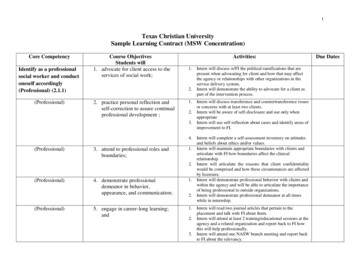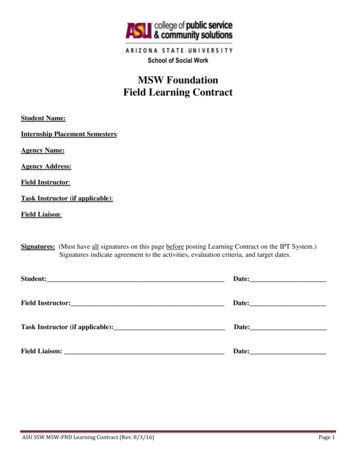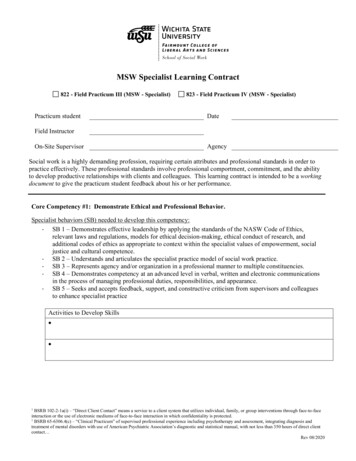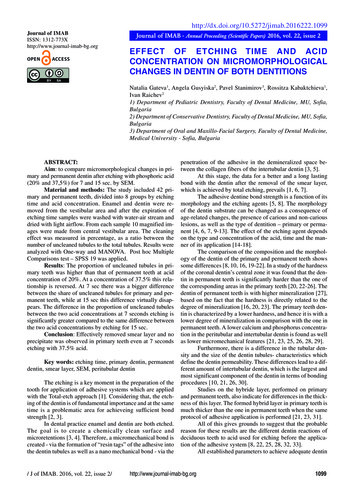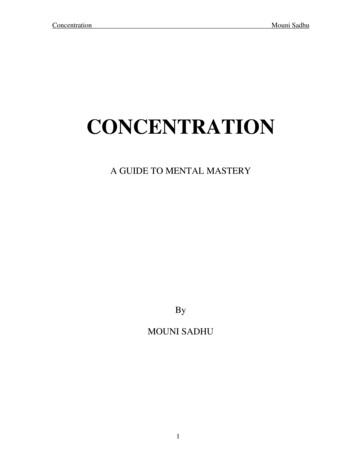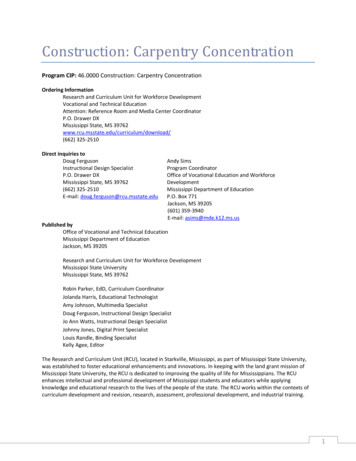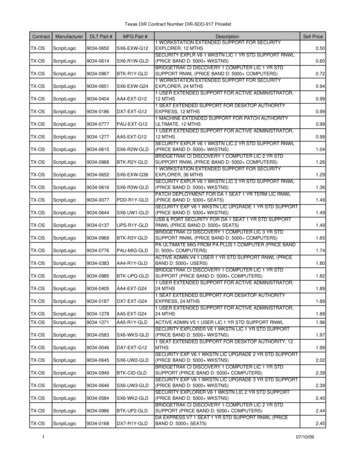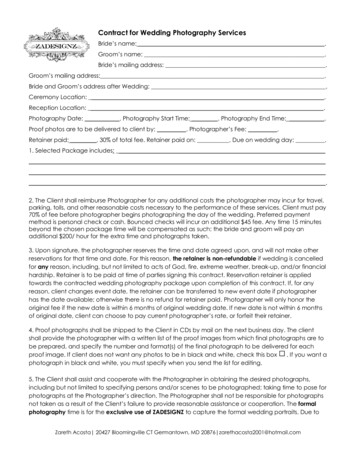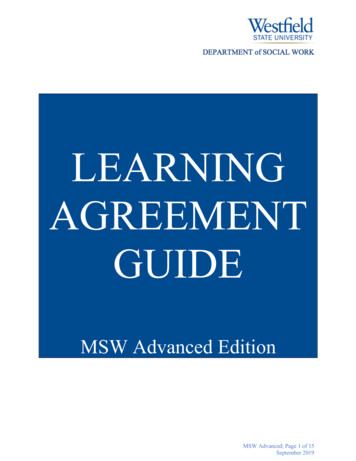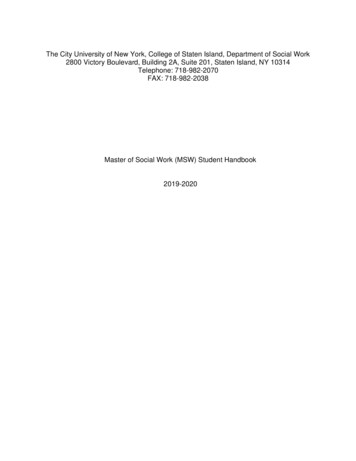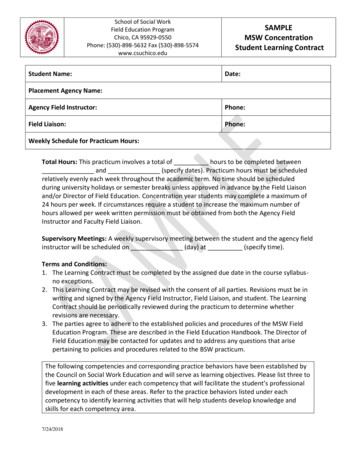
Transcription
School of Social WorkField Education ProgramChico, CA 95929-0550Phone: (530)-898-5632 Fax (530)-898-5574www.csuchico.eduStudent Name:SAMPLEMSW ConcentrationStudent Learning ContractDate:Placement Agency Name:Agency Field Instructor:Phone:Field Liaison:Phone:Weekly Schedule for Practicum Hours:Total Hours: This practicum involves a total of hours to be completed betweenand (specify dates). Practicum hours must be scheduledrelatively evenly each week throughout the academic term. No time should be scheduledduring university holidays or semester breaks unless approved in advance by the Field Liaisonand/or Director of Field Education. Concentration year students may complete a maximum of24 hours per week. If circumstances require a student to increase the maximum number ofhours allowed per week written permission must be obtained from both the Agency FieldInstructor and Faculty Field Liaison.Supervisory Meetings: A weekly supervisory meeting between the student and the agency fieldinstructor will be scheduled on (day) at (specify time).Terms and Conditions:1. The Learning Contract must be completed by the assigned due date in the course syllabusno exceptions.2. This Learning Contract may be revised with the consent of all parties. Revisions must be inwriting and signed by the Agency Field Instructor, Field Liaison, and student. The LearningContract should be periodically reviewed during the practicum to determine whetherrevisions are necessary.3. The parties agree to adhere to the established policies and procedures of the MSW FieldEducation Program. These are described in the Field Education Handbook. The Director ofField Education may be contacted for updates and to address any questions that arisepertaining to policies and procedures related to the BSW practicum.The following competencies and corresponding practice behaviors have been established bythe Council on Social Work Education and will serve as learning objectives. Please list three tofive learning activities under each competency that will facilitate the student’s professionaldevelopment in each of these areas. Refer to the practice behaviors listed under eachcompetency to identify learning activities that will help students develop knowledge andskills for each competency area.7/24/2018
**Title IV-E, Mental Health, and Gerontology stipend students will need to list the appropriatecorresponding CalSWEC behaviors. CalSWEC Curriculum Competencies are provided on thefield website: tencies.shtmlCompetency 1 - Student Demonstrates Ethical and Professional BehaviorIn the space below, discuss what activities will be used to demonstrate, monitor &evaluate the following: Makes ethical decisions by applying the standards of the NASW Code of Ethics,relevant laws and regulations, models for ethical decision-making, ethical conduct ofresearch, and additional codes of ethics as appropriate to context Uses reflection and self-regulation to manage personal values and maintainprofessionalism in practice situations Demonstrates professional demeanor in behavior; appearance; and oral, written,and electronic communication Uses technology ethically and appropriately to facilitate practice outcomes Uses supervision and consultation to guide professional judgment and behaviorLearning Activity/Task To BeAssignedExpectedCompletionDateMethod ofEvaluationIV-E/MH/Geroonly list CalSWECBehaviors(ex/CW1.1,BH1.1 orAG1.1)*Will the student berequired to use apersonal vehicle tocomplete this learningactivity/task?Develop an ethical decision makingtree congruent with agency protocol10/15/18CW 1.7Yes/NoDescribe HIPAA regulations to eachclient servedDailyCW 1.7Yes/NoParticipate in three individualmeetings with clients and journalabout personal values they wereaware of experiencing11/15/18Review withsupervisor, seekclarification onany principles thatare unclearBe able to explainHIPAA tosupervisorShare journal withsupervisor anddifferentiatepersonal valuesfrom professionalvaluesCW 1.4Yes/NoCompetency 2- Students Engage Diversity and Difference in PracticeIn the space below, discuss what activities will be used to demonstrate, monitor & evaluatethe following: Applies and communicates understanding of the importance of diversity anddifference in shaping life experiences in practice at the micro, mezzo, and macro levels7/24/2018
Presents themselves as learners and engages clients and constituencies as experts oftheir own experiences Applies self-awareness and self-regulation to manage the influence of personal biasesand values in working with diverse clients and constituenciesIV-E/MH/GeroLearning Activity/Task To BeExpectedMethod of*Will the student beonly AssignedCompletion Evaluationrequired to use alistCalSWECDatepersonal vehicle toBehaviorscomplete this learning(ex/CW2.1,activity/task?BH2.1 or AG2.1)Research three articles relevant todiversity that affects a clientpopulation the student has notpreviously worked withPrepare a diversity awareness trainingfor agency staff11/30/18Review articleswith supervisorCW 2.4Yes/No3/15/19CW 2.1Yes/NoStudent will record personal reactionsand cultural practices implementedwith clients served12/1/18Review trainingand scheduledate for trainingwith supervisorDiscussobservationswith supervisorCW 2.2Yes/NoCompetency 3 - Students Advance Human Rights and Social, Economic, and EnvironmentalJusticeIn the space below, discuss what activities will be used to demonstrate, monitor & evaluate thefollowing: Applies their understanding of social, economic, and environmental justice to advocatefor human rights at the individual and system levels Engages in practices that advance social, economic, and environmental justiceIV-E/MH/GeroLearning Activity/Task To BeExpectedMethod of*Will the student beonlyAssignedCompletion Evaluationrequired to use alist CalSWECDatepersonal vehicle toBehaviorscomplete this learning(ex/CW3.1,activity/task?BH3.1 orAG3.1)Identify cultural/social/economicneeds of client population serviced byagency and organize agency effort toaddress needs12/15/18Attend at least one political eventthat will affect the agency’s servicesor population served12/15/187/24/2018Discuss needswith supervisorand identifyapproach toorganizingagency effortDiscussobservationswith supervisorand presentCW 3.1Yes/NoCW 3.2Yes/No
outcome ofevent to staffCompetency 4 - Students Engage in practice-informed Research and Research-informedPracticeIn the space below, discuss what activities will be used to demonstrate, monitor & evaluate thefollowing: Uses practice experience and theory to inform scientific inquiry and research Applies critical thinking to engage in analysis of quantitative and qualitative researchmethods and research findings Uses and translates research evidence to inform and improve practice, policy, andservice deliveryLearning Activity/Task To BeAssignedExpectedCompletionDateMethod ofEvaluationIV-E/MH/Geroonly list CalSWECBehaviors(ex/CW4.1,BH4.1 orAG4.1)*Will the student berequired to use apersonal vehicle tocomplete this learningactivity/task?Research and read three to fivearticles related to population served12/1/18CW 4.2Yes/NoProvide staff training on researchcompleted12/15/18CW 4.4Yes/NoIdentify agency program that has littledata to support interventions usedand identify program evaluation toaddress this need3/15/18Prepare one pagebullet pointsummary ofresearch and howit can informpractice withrelevantpopulation andreview withsupervisorReview bestpractices withsupervisor andschedule trainingto shareinformation withagency staffPresent programevaluationproposal tosupervisor anddetermine prosand cons tomoving forward toadministrationCW 4.1Yes/No7/24/2018
Competency 5 – Students Engage in Policy PracticeIn the space below, discuss what activities will be used to demonstrate, monitor & evaluate thefollowing: Identifies social policy at the local, state, and federal level that impacts well-being,service delivery, and access to social services Assesses how social welfare and economic policies impact the delivery of and access tosocial services Applies critical thinking to analyze, formulate, and advocate for polices that advancehuman rights and social, economic, and environmental justiceLearning Activity/Task To BeAssignedExpectedCompletionDateMethod ofEvaluationIV-E/MH/Geroonly list CalSWECBehaviors(ex/CW5.1,BH5.1 orAG5.1)*Will the student berequired to use apersonal vehicle tocomplete this learningactivity/task?Attend agency advisory boardmeeting and record policies discussed11/1/18CW 5.2Yes/NoAttend Legislative Lobby Days4/15/19CW 5.3Yes/NoResearch any current legislation thatwill impact agency and prepare factsheet regarding impact of legislation,provide this overview to agency staffduring a staff meeting3/15/19Share observationof meeting andpolicies discussedwith supervisorPrepare summaryof legislative billslobbied for andshare withsupervisor andagency staffPresent summaryand fact sheet tosupervisor andstaffCW 5.1Yes/NoCompetency 6 – Students Engage with Individuals, Families, Groups, Organizations, andCommunitiesIn the space below, discuss what activities will be used to demonstrate, monitor & evaluate thefollowing: Applies knowledge of human behavior and the social environment, person-inenvironment, and other multidisciplinary theoretical frameworks to engage with clientsand constituencies7/24/2018
Uses empathy, reflection, and interpersonal skills to effectively engage diverse clientsand constituenciesIV-E/MH/Geroonly list CalSWECBehaviors(ex/CW6.1,BH6.1 orAG6.1)Learning Activity/Task To BeAssignedExpectedCompletionDateMethod ofEvaluationDevelop list of questions/commentsto elicit client input for developingtreatment goals. Use this list todevelop 5-7 interventions that reflectclient/consumer inputIdentify elements oftransference/countertransferencethat emerge when engaging withclient systems.3/15/19Share list withCW 6. 1supervisor andreview mutuallyagreed upontreatmentProcess in journal CW 6.4and follow up withAFI duringsupervisionYes/NoReview 2 training videos and/or 3research articles on best practices forengagement with client systems.12/15/18Self-Reflection inJournal on whattechniquesmatched yourprofessional styleYes/No12/1/18CW 6.2*Will the student berequired to use apersonal vehicle tocomplete this learningactivity/task?Yes/NoCompetency 7 – Students Assess Individuals, Families, Groups, Organizations, andCommunitiesPlease indicate how and what skills will be demonstrated with one or more of the followingclient groups:Individual therapy sessions using different meta theories such as CBT, strengthsIndividualsbased, Motivational Interviewing, person in environment, etc. Learning how toconduct intake assessments, measuring achievable goals and objectives, writing atreatment plan, diagnosing using the DSM-5, writing case notes using medical billingsuch as: rehab services, MH individual therapy services, collateral, psycho-education,etc. Will also hold a caseload of 3-7 clients.Will work with client systems in micro, macro, mezzo level, in connecting clients andFamiliesfamilies. Will shadow Strengthening Families in the Spring Semester.GroupsWill co-facilitate a grief & loss group called, "Healing After Loss". Will beshadowing coaches during groups at Healing House, will conduct a studyexploring stigma reduction within the clients.Organizations7/24/2018Will be researching about legislation that funds/mandates/drives organization,identify models that guide organization operations. Will be conducting a study on
Communitiesstigma reduction within clients that attends Healing House. Will be collecting dataand interpreting data about stigma reduction. Will present findings to AFI, HealingHouse, and agency staff.Will provide linkage services (when necessary) to connect clients to communityresources. Will be identifying resources available to client systems. Will also beresearching resources that are available within local area. Identify communitystrengths and barriers.In the space below, discuss what activities will be used to demonstrate, monitor & evaluate thefollowing: Collects and organizes data, and applies critical thinking to interpret information fromclients and constituencies Applies knowledge of human behavior and the social environment, person-inenvironment, and other multidisciplinary theoretical frameworks in the analysis ofassessment data from clients and constituencies Develops mutually agreed-on intervention goals and objectives based on the criticalassessment of strengths, needs, and challenges within clients and constituencies Selects appropriate intervention strategies based on the assessment, researchknowledge, and values and preferences of clients and constituenciesLearning Activity/Task To BeAssignedExpectedCompletionDateMethod ofEvaluationIV-E/MH/Geroonly list CalSWECBehaviors(ex/CW7.1,BH7.1 orAG7.1)*Will the student berequired to use apersonal vehicle tocomplete this learningactivity/task?Review five to ten client files,assessing for evidence of client goalsand comparing with interventionplans3/1/19Reviewobservations withsupervisorCW 7.3Yes/No11/15/18Debrief sessionsobserved withstaff andsupervisorElicit feedbackfrom AFI duringsupervisionCW 7.1Yes/NoCW 7.4Yes/NoObserve three to five agency staffcompleting client assessments5/1/19Complete three to five writtenassessment tools and supportingprogress notes.Competency 8 – Students Intervene with Individuals, Families, Groups, Organizations, andCommunities7/24/2018
Please indicate how and what skills will be demonstrated with one or more of the followingclient groups:Individual therapy sessions using different meta theories such as CBT, strengthsIndividualsbased, Motivational Interviewing, person in environment, etc. Learning how toconduct intake assessments, measuring achievable goals and objectives, writing atreatment plan, diagnosing using the DSM-5, writing case notes using medical billingsuch as: rehab services, MH individual therapy services, collateral, psycho-education,etc. Will also hold a small case load.FamiliesWill explore family dynamics utilizing a family systems theory framework, and cofacilitate family support meetingsGroupsWill research and implement group facilitation skills while familiarizing self withcurriculum and group process strategiesOrganizations Will be researching about MHSA Act, Wellness and Recovery Model, grief & loss,and Anti-stigma reduction strategies. Will be conducting a study with to study stigmareduction within clients that attends Healing House. Will be collecting data andinterpreting data about stigma reduction. Will present findings to AFI, HealingHouse, and agency staff. Identify ways to promote advocacy strategies andempower clientele and staff.Will provide linkage services (when necessary) to connect clients to communityCommunitiesresources. Will be identifying resources available to client systems. Will also beresearching resources that are available within local area. Assist client system inattaining meaningful roles within their communities. Identify ways to promoteadvocacy strategies and empower communities.In the space below, discuss what activities will be used to demonstrate, monitor & evaluate thefollowing: Critically chooses and implements interventions to achieve practice goals and enhancecapacities of clients and constituencies Applies knowledge of human behavior and the social environment, person-inenvironment, and other multidisciplinary theoretical frameworks in interventions withclients and constituencies Uses inter-professional collaboration as appropriate to achieve beneficial practiceoutcomes Negotiates, mediates, and advocates with and on behalf of diverse clients andconstituencies Facilitates effective transitions and endings that advance mutually agreed-on goalsLearning Activity/Task To BeAssigned7/24/2018ExpectedCompletionDateMethod ofEvaluationIV-E/MH/Geroonly list CalSWECBehaviors(ex/CW8.1,*Will the student berequired to use apersonal vehicle tocomplete this learningactivity/task?
BH8.1 orAG8.1)Develop timeline for terminationactivities for 5-7 clients4/15/19Identify and review 3 theoreticalmodels that are evidenced based forworking with client systems2/15/19Manage a caseload of 3-7 clients3/1/19Share and reviewtimelines withsupervisorPresent modelsin supervisionand discussCW 8.4Yes/NoCW 8.1Yes/NoDiscuss andreview in weeklysupervisionCW 8.3Yes/NoCompetency 9 – Students Evaluate Practice with Individuals, Families, Groups, Organizations, andCommunitiesIn the space below, discuss what activities will be used to demonstrate, monitor & evaluate thefollowing: Selects and uses appropriate methods for evaluation of outcomes Applies knowledge of human behavior and the social environment, person-inenvironment, and other multidisciplinary theoretical frameworks in the evaluation ofoutcomes Critically analyzes, monitors, and evaluates intervention and program processes andoutcomes Applies evaluation findings to improve practice effectiveness at the micro, mezzo, andmacro levelsLearning Activity/Task To BeAssignedExpectedCompletionDateMethod ofEvaluationIV-E/MH/Geroonly list CalSWECBehaviors(ex/CW9.1,BH9.1 or AG9.1)*Will the student berequired to use apersonal vehicle tocomplete this learningactivity/task?5/1/19Discuss insupervision andself-reflect injournalCW 9.2Yes/No12/1/18Process withsupervisor,CW 9.3Yes/No3/1/19Review withsupervisorCW 9.3Yes/NoAdminister 3-5 session/serviceevaluation tools to client systemReview 5 evaluation tools in client filebringing 3 questions for furtherexploration with supervisorResearch instruments that 3 othercounties/agencies are utilizing7/24/2018
5/1/19Attend 3 Quality Managementmeetings to review programevaluation issues at local, state andfederal level.Debrief withQM staff andAFICW 9.2Yes/No*If a student will be required to use a privately-owned vehicle, the agency is required toobtain proof of a valid California driver’s license, automobile registration, and insurancemeeting the State of California minimum requirements from the student.Signatures: The parties acknowledge their understanding and consent to this Learning Contractwith their signatures below.StudentDateAgency Field InstructorDateAgency Task SupervisorDateField LiaisonDate7/24/2018
writing and signed by the Agency Field Instructor, Field Liaison, and student. The Learning Contract should be periodically reviewed during the practicum to determine whether revisions are necessary. 3. The parties agree
